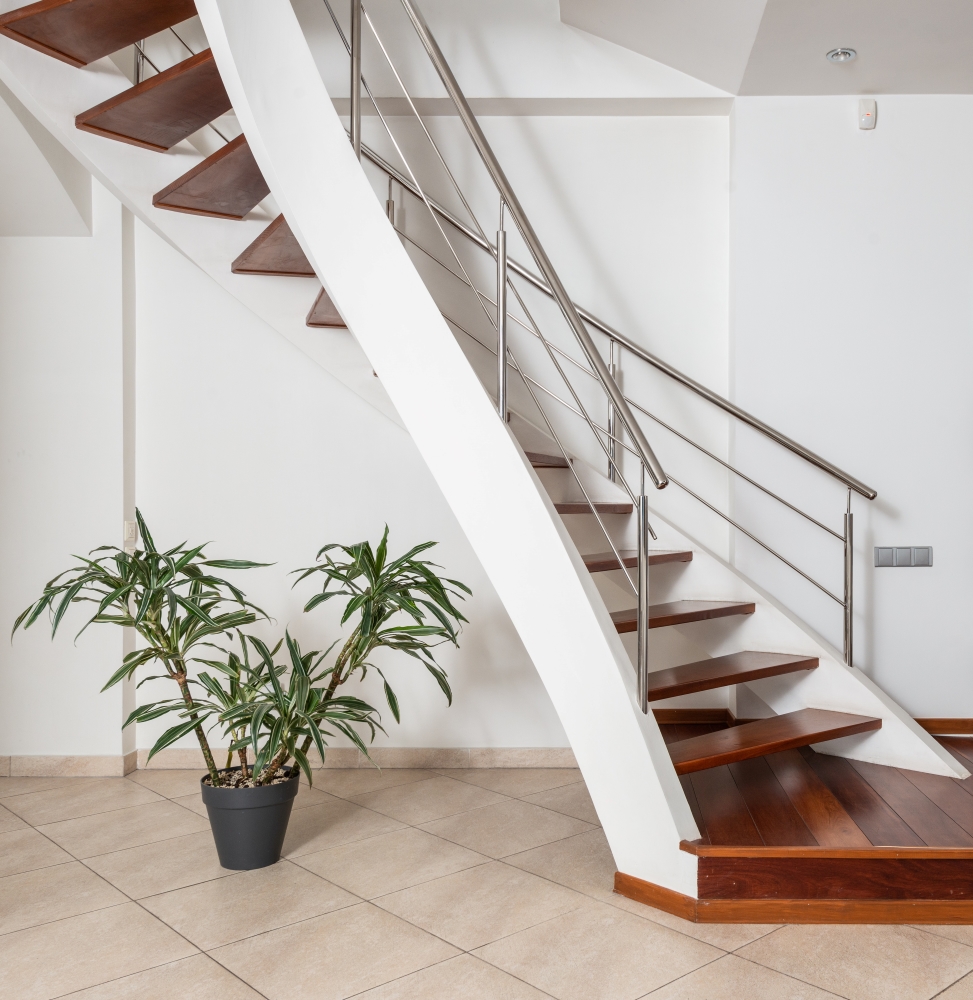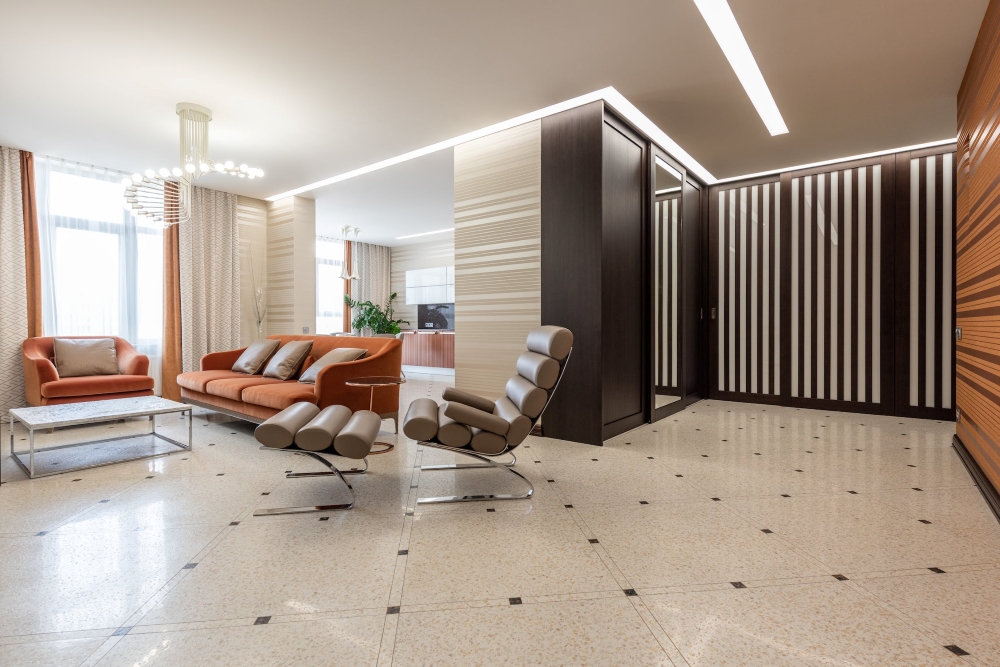The floor tiles for halls are as important as every other room element. It might not appear so, but how your floor tiles look determines your living room's appearance. Then why waste a golden chance to amp up the look of the hall? Choosing the right colour, material, and design can make your guests stare at your hall in awe. So, let us look at the different floor tiles to put harmony in your hall’s interior design:
Floor tiles design for hall, living room
Let us have a peek into the different floor tiles designs used for living rooms:
Marble

Marble is synonymous with elegance and simplicity. If you are a classics fan, marble is your choice for living room floor tiles. You can have unique patterns that come in different colours that suit your halls. Besides visual appeal, marble is also durable and has natural cooling properties, making it ideal for hot climate regions.
Granite

As one of the hardest natural stones, granite is known for its toughness and longevity. With their distinct textures and colours, these tiles suit any hall interior and furniture type. Additionally, granite is easy on the pocket when it comes to maintenance. So, consider granite for a long-lasting yet beautiful floor tile design.
Wood

Known for their warmth, real wood tiles display unique grain designs, knots, and wooden textures that make wood pieces distinct. These tiles are more resistant to moisture and temperature changes and do not wear out easily. Moreover, wooden tiles are often compatible with underfloor heating systems that help maintain a warm room temperature during winter.
Ceramic

Ceramic is an eco-friendly and versatile hall floor tile. These tiles are made from glazed clay and fired at high temperatures. They resist scratches and other damages caused by heavy use or foot traffic, making them durable. Therefore, these easy maintenance and cost-effective tiles can be your go-to option if you want a creative design within budget.
Vinyl

Vinyl flooring tiles are made up of multiple layers of synthetic materials. You do not need specialised help as these tiles are easy to install. They come with self-adhesive backing or click-lock systems that make them fit easily. Not just the functionality, but Vinyl tiles also offer multiple design options from colours, patterns, and textures. In addition, the cushioned surface gives a comfortable feel to the feet.
Contrast

Source: Pinterest/Royal Home Flooring
You can create a dynamic space within your living rooms with contrasting floor tiles. The commonly used contrast designs have contrasting colours, patterns, sizes, textures, and materials. You can choose more than one colour or pattern to go with the interior of your room. The concept may look mismatched, but the finished floor design matches perfectly with the overall aesthetics of the living room.
Vitrified

Vitrified tiles are produced using a technique called vitrification, in which a mixture of clay, silica, quartz, and feldspar is burnt at very high temperatures to produce a dense and impenetrable tile.
These tiles are moisture resistant with a low water absorption rate of 0.5 percent. Their colour and designs do not easily fade away from sunlight exposure. This makes them ideal for halls with wide-open and large windows. If you are allergic to dust, vitrified tiles are the best for you as they are allergy-friendly and do not collect dust, pollen, or other allergens.
Ceramic floor tiles designed for the hall, living room
The commonly used ceramic floor tiles come in various designs. Here are a few for you to consider:
Digitally printed tiles

Source: Pinterest/Halo Tiles Bathrooms
The beauty of digitally printed ceramic floor tiles is that they can feature highly detailed designs. These tiles are created using advanced printing technology to create patterns resembling marble, wood, or stone on ceramic.
Patterned tiles

Source: Homes To Love AU
These ceramic floor tiles feature decorative motifs and designs repeated across the tile surface. The patterns include geometric shapes, florals, and intricate abstract designs. Patterned tiles give your living space more character and visual intrigue.
Morrocan tiles

Use Moroccan ceramic floor tiles to add an exotic touch and striking look to your living rooms. These floor tiles have geometric patterns with a mix of vibrant colours. Combining classic and modern design elements, these tiles are inspired by Moroccan culture.
Wood-look tiles

Source: Pinterest/Apartment Therapy
Wood-look ceramic floor tiles are a good option if you want a wood-like feel to the floor without using wood. They provide the durability and ease of maintenance of ceramic tiles and wood's cosiness and beauty.
Top colours for floor tiles design for the hall
When it comes to choosing the colours for floor tiles, it depends on the room’s interior and the atmosphere you want to create. However, here are some top colours often used for hall floor designs:
Neutral tones

Neutral tones are the evergreen choice for floor tiles in halls. Colours such as cream, beige, or light grey often suit any design and furniture type. These shades also make the other elements in the room stand out.
Earthy tones

Warm and natural-feeling earth tones like brown, terracotta, or warm grey convey a warm and inviting atmosphere. Earthy tones complement the rustic or contemporary design styles beautifully.
Cool tones

Source: Pinterest Tile Club
Cool colours such as blue or green are perfect for halls with ample natural light. These shares create a refreshing effect and blend perfectly with white, pastel or metallic shade furniture.
Dark tones

Source: Pinterest/HGT
Dark shades of deep grey, charcoal, or black, can add a feeling of grandeur. With lighter walls or furnishings, these colours can create a stunning contrast. Darker tones look better in halls having enough natural light.
Bold and vibrant tones

Source: Pinterest/Flooring Superstore
If you are the expressive type, you might like bold and vibrant colours such as red, orange, and purple. However, make sure these colours do not overpower other elements in the room.
Monochromatic tones

Monochromatic colours are very common in the floor tiles space. One-colour tiles have a cohesive look that creates a sense of unity and flow. These colours naturally increase the visual appeal of other interior elements in the room.
 Could the article help you understand the topic?
Could the article help you understand the topic?
Latest patterns for floor tiles design for the hall
Here are some of the latest patterns for hall floor tiles design that are trending in the market:
Geometric shapes

Geometric patterns such as hexagons, chevrons, or Moroccan-inspired motifs are popular for hall floor tiles. These shapes create a modern look combined with simple and plain wall colours and furniture.
Encaustic tiles

Source: Pinterest/Overstock
These tiles feature repetitive designs that create a pattern when placed together. These tiles look good with wall and furniture colours that contrast the patterns present in the tiles.
Terrazzo tiles

These tiles are made of diverse material chips sealed in a cement or resin foundation. The resin or epoxy poured into the flooring makes these tiles one of the most expensive.
Textured tiles

Tiles with textured surfaces, such as 3D patterns or embossed motifs, can give your hall floor depth and aesthetic appeal.
Large format tiles

With fewer gap lines, these tiles, which are normally 24x24 inches or larger, produce a smooth and seamless appearance. Large format tiles are ideal in modern or minimalist settings.
Floor tiles prices in India
In India, floor tiles' cost differs for the materials used. For marble tiles, the price ranges from Rs 15 per sq ft to Rs 3000 per sq ft, depending on the quality. For ceramic and vitrified tiles, the price starts from Rs 37 per sq ft and goes up to Rs 327 per sq ft. For granite, the price ranges from approximately Rs 25 to Rs 110.
By size, there are two popular tiles. The price of 2x2 tiles ranges from Rs 55 per sq ft to Rs 111 per sq ft. For 2x4 tiles, the prices vary from Rs 67 per sq ft to Rs 81 per sq ft.
How to choose the right type of living room floor tiles design?
Choosing the right type of floor tile design for your living room in India is a crucial decision that can greatly impact the aesthetics and ambience of the space. Here's a step-by-step guide on how to select the right floor tile design for your living room:
Determine Your Style and Theme
Start by identifying the style or theme you want for your living room. Do you prefer a traditional, contemporary, minimalist, or eclectic look? Your chosen style will guide your tile selection.
Consider the Size of the Room
The size of your living room matters when choosing floor tiles. For smaller living rooms, large-format tiles can create a sense of spaciousness. In larger rooms, you have more flexibility in tile size and pattern.
Select the Right Tile Material
In India, common tile materials for living room floors include porcelain, ceramic, vitrified, and natural stone. Porcelain and vitrified tiles are popular choices due to their durability and versatility. Natural stone, such as marble or granite, can offer a luxurious look but may require more maintenance.
Texture and Finish:
Decide on the texture and finish of the tiles. Options include glossy, matte, or textured finishes. A glossy finish can add elegance but may be slippery when wet, while matte or textured finishes offer more grip.
Pattern and Design
Determine whether you want a uniform tile design or a patterned layout. Large-format tiles with subtle patterns or wood-look tiles are popular for living rooms. Alternatively, you can create a focal point with a decorative rug-like tile pattern in the center.
Maintenance and Durability
Think about your maintenance preferences. Some tile types and finishes are easier to clean and maintain than others. Ensure that the tiles are durable enough to withstand the expected foot traffic in your living room.
As you can see, you can elevate the floor tiles design for the hall in several ways. From budget-friendly tiles to eco-friendly tiles, you can choose from multiple options to create a hall design of your liking. So, take your time and choose a floor tile design that helps you design your dream hall.


































